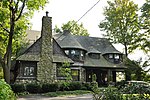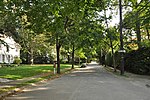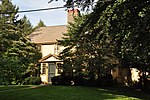Chestnut Hill station (MBTA)
Former Boston and Albany Railroad stationsGreen Line (MBTA) stationsMassachusetts Bay Transportation Authority stubsMassachusetts railway station stubsRailway stations in Norfolk County, Massachusetts ... and 2 more
Railway stations in the United States opened in 1959Tram stubs

Chestnut Hill station is a light rail station on the MBTA Green Line D branch, located off Hammond Street north of Massachusetts Route 9 in the Chestnut Hill neighborhood of Newton, Massachusetts. The station has two side platforms serving the line's two tracks. Chestnut Hill station is not accessible.
Excerpt from the Wikipedia article Chestnut Hill station (MBTA) (License: CC BY-SA 3.0, Authors, Images).Chestnut Hill station (MBTA)
Hammond Street, Newton Chestnut Hill
Geographical coordinates (GPS) Address Website Nearby Places Show on map
Geographical coordinates (GPS)
| Latitude | Longitude |
|---|---|
| N 42.326944444444 ° | E -71.164722222222 ° |
Address
Hammond Street
02467 Newton, Chestnut Hill
Massachusetts, United States
Open on Google Maps









